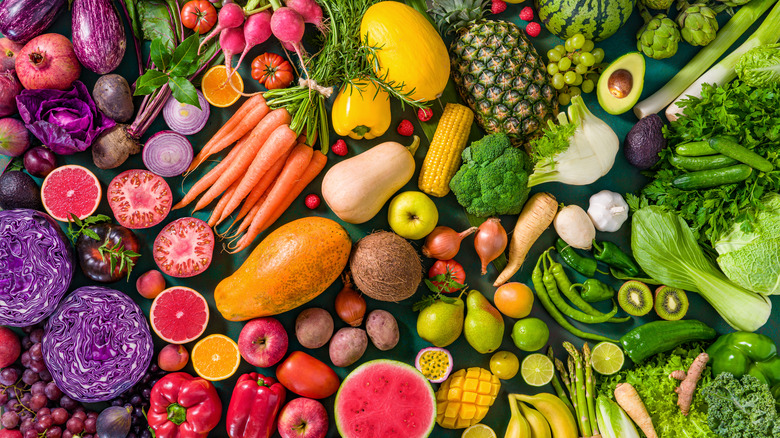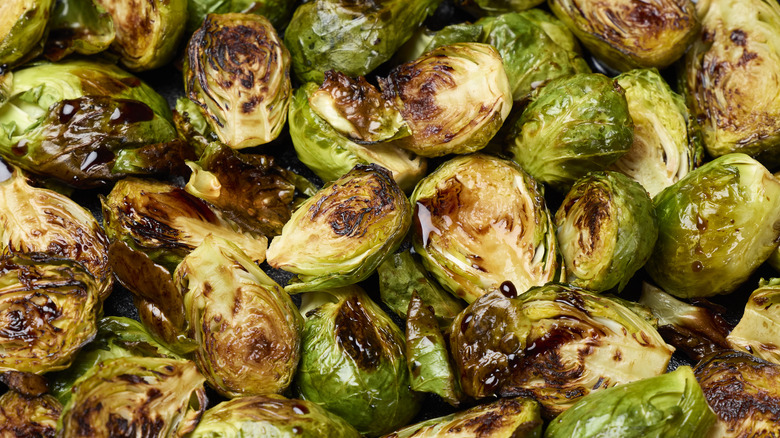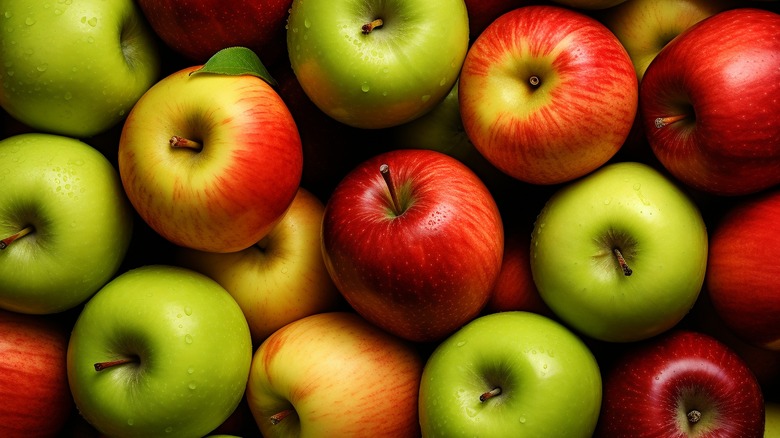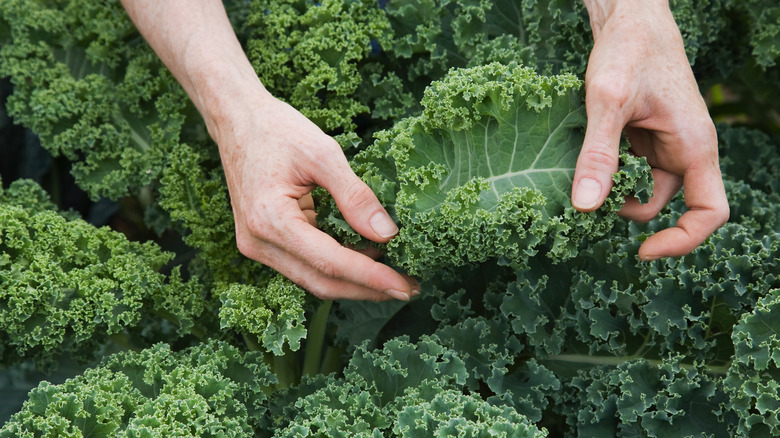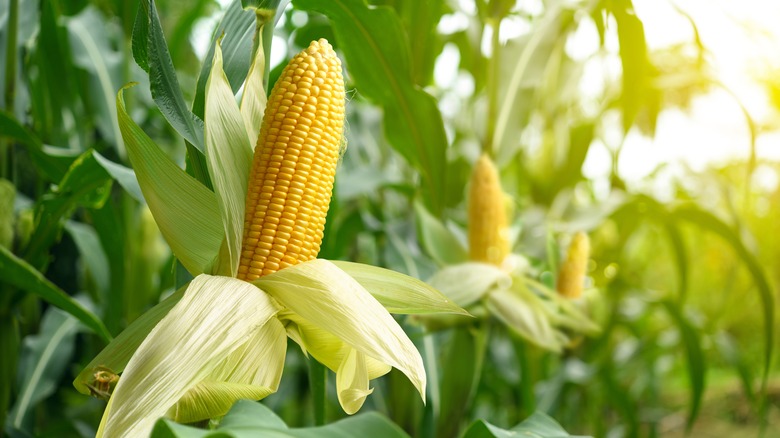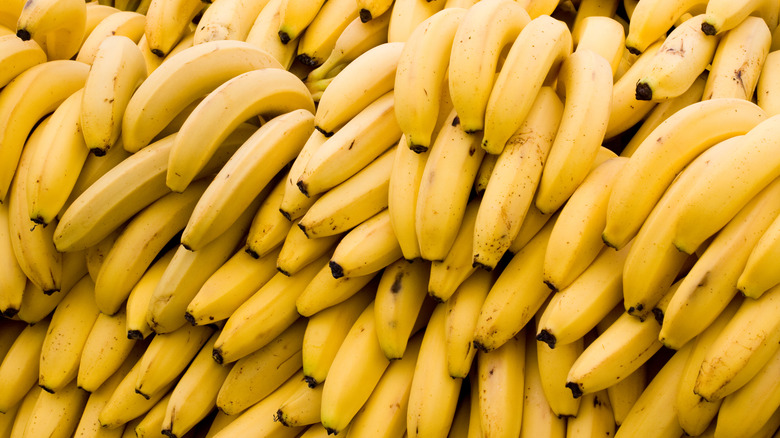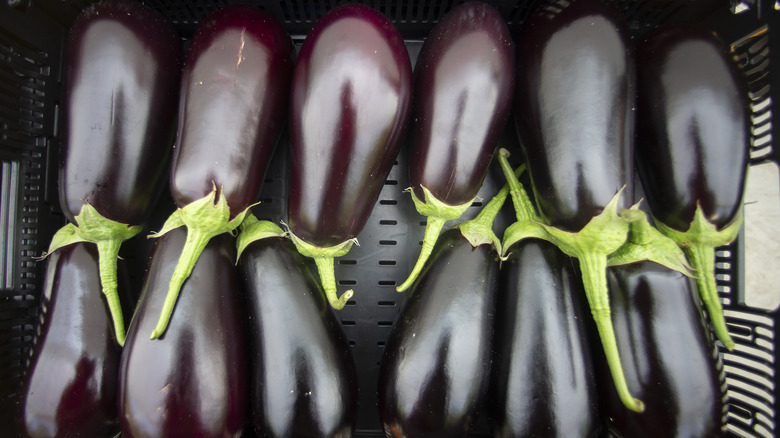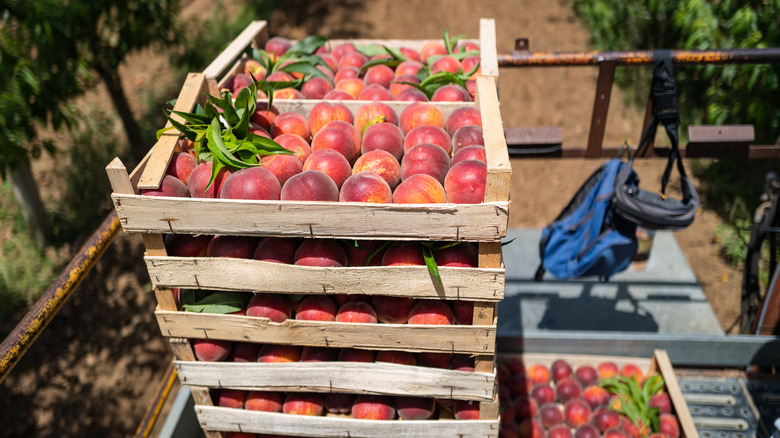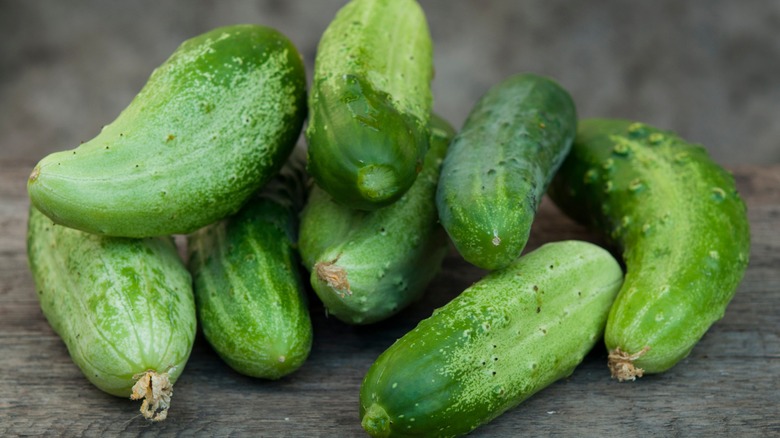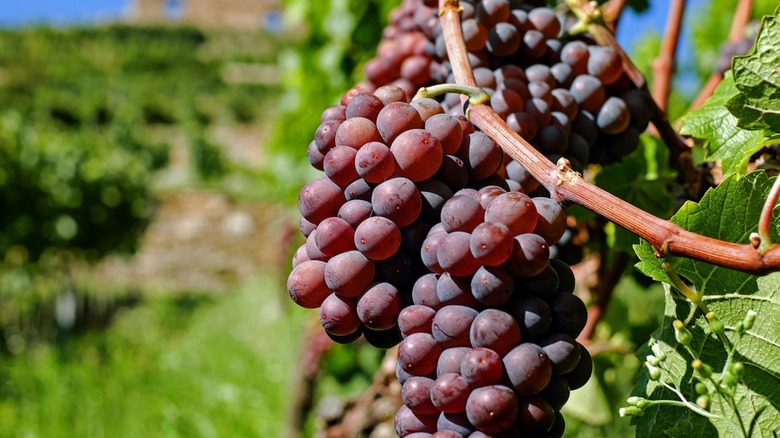10 Fruits And Vegetables That Don't Taste Like They Used To
Even if you try to avoid processed foods, you're probably eating at least a few — likely where you least expect them. You might be shocked to learn that even the fruits and vegetables on your plate have been subjected to many adjustments over the years. Don't fret, though: Most of these transformations were not cooked up in a lab. The flavor profile of fruits and vegetables can change over time due to many factors, like major weather events, farming practices, and genetic mutations (some even man-made!).
Sometimes a major disaster brings this change about. If there's a large flood and only one strain of a crop survives, for example, the resulting produce will reflect that strain's taste, which might be different from the previously dominant flavor. Other times, farmers might notice that a fruit or vegetable with a certain taste profile sells better than others. That farmer is likely to cultivate whatever crops match these best-sellers as closely as possible. But you don't have to take our word — or these examples — for it. Whether it's through the modern marvels of food science or a slight shift over the generations, these are 10 fruits and vegetables that don't taste like they used to.
1. Brussels sprouts are way less bitter these days
If you avoid eating Brussels sprouts because you remember them being too bitter to enjoy while growing up, you should give them another shot. The little green vegetable's taste has changed significantly over the years due to the work of a few Dutch scientists, namely Hans van Doorn. Through his research, he was able to isolate the exact compounds that make Brussels sprouts taste bitter. From there, garden suppliers in the Netherlands were able to start selling seeds that had less and less of that chemical, called glucosinolate. Little by little, this unpleasant taste is disappearing.
"We have a whole gene bank here in our cellars, with all the possible Brussels sprouts varieties that were available from the past," Cees Sintenie, a plant breeder at Dutch food company Bejo Zaden told NPR. After much trial and error, Bejo Zaden and other companies had effectively altered the taste of Brussels sprouts. "From then on, the taste was much better. It really improved," he shared. This happened in the 1990s, and since then, the popularity of Brussels sprouts has been a bit slow going; many diners hold onto the old flavor's negative associations. But now that you know they aren't as bitter as you remember, you should give them another go. And whatever you do, stop boiling them!
2. The first apples had a variety of different flavors
While the apples we know and love come in plenty of options — Granny Smith, Gala, Red Delicious, you name it — they all still taste apple-y. Whether they are sweet, sour, tart, or juicy, most of us would still be able to identify the fruit in a line-up. However, in the mountains of Kazakhstan, there grows a type of fruit known as Malus sieversii. This apple is thought to be the main precursor to most modern apples, and it comes in many different flavors — some of which taste entirely unexpected. To this day, apple enthusiasts still travel to the Almaty region to try fruits that taste more like berries than the shiny red orbs we know so well. They can even sample apples that have the fennel-esque taste of black licorice.
These apples grow wild on the vine and are generally not genetically engineered or selectively bred in any way. Instead, they get their flavor from cross-pollination via bees and birds. The resulting forest is dense, but it's an incredible haven for "original" apples. "It is a remarkable sight," apple farmer John Selborne told the BBC. "You go into these forests and you find that the apple is the predominant species. It's totally chaotic because everything is intertwined, they're difficult to walk through." Yet from this chaos emerged the apples we buy today at the grocery store — with a very different taste.
3. Tastier kale is on the horizon
In the early 2020s, leafy green kale had a bit of a renaissance, turning it from a boring salad option into a delicious snack all its own. However, despite its surge in popularity, some just can't get past its dense, earthy taste. The reason kale hasn't had a flavor makeover like Brussels sprouts have enjoyed is that most growers think more about profits rather than taste. The more kale they grow, the more potential for their business to stay afloat. Flavor hasn't mattered that much — until now. A company called Pairwise has set out to edit the very DNA of kale to make it less bitter and more appealing to the masses.
"From a gene-editing perspective, I think where taste comes in is that we can remove things that people don't like," co-founder and CEO Tom Adams told Scientific American. "It's a lot more difficult to think about how you can bring in the really complex, great tastes." The new varieties won't be cooked up in a lab, but curated from controlled crops in special greenhouses. Each batch will be taste-tested, and only the best will be bred again, resulting in delicious, sweeter, and significantly less bitter kale.
4. Corn wasn't always so sweet
The taste of corn has changed many times over the years, and it's entirely due to human intervention. As Bill Tracy, an agronomy professor at the University of Wisconsin, Madison told The Spokesman-Review, this is because corn is a "highly variable species [that is] relatively easy to manipulate." In fact, the corn you buy at the grocery store today might be up to 40% sugar, making it much sweeter than the corn your grandparents ate. This shift started to happen in the 1950s. Through his research, a botany professor at the University of Illinois named John Laughan found a gene in certain types of corn that makes it sweeter and produces less starch. American grocers and diners were not interested at first. But after this newer type of corn became popular overseas through exportation, its popularity at home took off as well.
"Super sweets became very important in the processing industry," Tracy detailed. "It's because you don't have to add the sugar. Traditional corn you added sugar to the cans because it really wasn't very sweet." So if you remember biting into an ear of corn being a more savory experience in years past, you aren't imagining it — everything really is sweeter now.
5. Bananas were once sweeter and firmer
Bananas as we know them today arrived in the USA in the late 19th century. These fruits were big, yellow, and curved, as you might expect. But there was one big difference that set them apart from their modern counterparts: the taste. This original type of banana is called the Gros Michel. Americans enjoyed the fruit for about 100 years until a fungus known as Fusarium oxysporum, or "Panama disease," caused a massive crop loss, effectively extinguishing the fruit. The Cavendish strain of banana appeared to fill the vacuum and is still the more widely available option to this day.
"I think the Gros Michel has a little bit more of a floral sweetness," Rane Roatta, co-owner of Miami Fruit, told Epicurious. "It's got that candy banana flavor, which to me is a little bit more of a tip-of-the-tongue flavor." This is a popular opinion; there's even a long-standing rumor that modern banana candy flavoring is based on the Gros Michel. This, the rumor goes, is why so many people don't like banana candy — it doesn't taste enough like the Cavendish we are used to. However, the difference is a lot more subtle than people might think. "Most people, if they were rushed, they wouldn't think twice about the difference," Roatta continued. "But if you're sitting there thinking about it, you can definitely taste a difference."
6. Carrots used to be more earthy
Believe it or not, carrots used to be white. But they carried a few recessive genes that contribute to vivid colors. Early carrot farmers likely grew the first colorful carrots on accident — but once they discovered the rich oranges and purples that were possible, they produced them on purpose through artificial selection. Orange carrots have a high content of beta-carotene, which is where their color comes from. They're also sweeter. The World Carrot Museum asserts that this unique flavor caused diners of the 15th and 16th centuries to prefer them. So passed the original earthy carrots — people just couldn't resist their sugary cousins.
One of the most popular types of carrot in modern times is the baby carrot. It's a perfectly polished, bright orange, sweet and crunchy snack. However, this vegetable has been carefully curated to suit the desires of the public. Back in the 1980s, Californian farmer Mike Yurosek created the baby carrot we know and love because he was tired of seeing so many carrots discarded due to their appearance. To reduce food waste, the sweet baby carrot was born. However, this saccharine snack would not have been possible without the bitter, earthy carrots of the past.
7. Eggplant used to be more bitter
Eggplants used to taste and look a whole lot different than they do now. While the modern eggplant that we know and love is large, deep purple in hue, and has a deep, savory, faintly sweet taste (especially after cooking over a low, slow flame), its predecessors were smaller and far more bitter. Research published in "The Annals of Botany" suggests that the eggplants consumed in ancient China were pellet-sized, only growing to their larger size through years of cultivation and observation. These eggplants also tasted markedly different. The "Qimin Yaoshu," a sixth century agricultural text, indicates they weren't beloved for their taste, and were likely bitter.
Eggplant changed as Chinese farmers of the time explored unique methods of cultivation, like exposing eggplants to sulfur to drive bitterness out of the flesh. Modern eggplants now hover in the happy medium between sweet and savory, and are capable of taking on a wide variety of other flavors through various cooking processes.
8. Natural peaches tasted savory, not sweet
Being "sweet as a peach" is a well-known modern saying. There's good reason for this: Today's peaches are sweet as can be, and often star in desserts like Peach Custard Pie. But "sweetness" and "peaches" didn't always go together. In fact, natural peaches weren't very sweet at all. Around 4000 BCE, farmers in China started working with what's now known as a natural peach. It was small, almost the size of a cherry, and is described as being sour, earthy, and significantly less juicy. In fact, some reports say that this peach tasted more like a lentil than the sweet, tangy peaches we are used to today.
The skin was also quite different than that of the modern peach, further changing the flavor. Peaches now have a thin, fuzzy skin that is easy to peel away with one's teeth and adds to the overall tang of the fruit. However, ancient peaches had a thick, waxy skin that was much harder to break through and chew. Even if the inside was sweet, gnawing away a borderline inedible skin to get there would still make eating the ancient peach a less than pleasant experience.
9. Cucumbers weren't always watery and light
People have been enjoying cucumbers as a snack for more than 3,000 years. Yet during that time, the fruit — yes, it's technically a fruit, as it has seeds and grows from a flowering plant — has changed a lot in size, texture, and taste. While ancient civilizations like the Greeks, Romans, and Egyptians ate cucumbers, they likely found them to be quite bitter. This is because cucumbers used to have more cucurbitacins in them than they do today. Cucurbitacins are a type of compound found in the pumpkin and gourd family, to which cucumbers belong. They make the food taste bitter to insects, birds, and mammals. This is a natural repellent — bitter food is hard to get down.
While you might still get the odd harsh note from a cucumber in modern times, food scientists have worked hard on selective breeding programs to stop this from happening. These days, cucumbers have a light, refreshing bite to them — which makes sense, as they're mostly water.
10. Grapes are constantly being modified
Even the uninitiated can tell the difference between red and green grapes. The former are commonly sweeter and the latter tend to be slightly more sour. They haven't always been exactly as they are now, though. Grapes have been a part of the human diet for more than 6,000 years, dating back to the Greeks, Romans, and Egyptians. Ever since those times, farmers have made adjustments to their crops to get the best flavor, size, and texture out of their grapes. In modern times, change happens just as often — and quicker.
"The whole process takes at least six years and sometimes up to 15 years," Horticulturalist David Cain told NPR when describing the cultivation of new types of grapes. Yet the process is worth it for both the success of the grape business and the overall enjoyment of the consumer. "A lot of fruit becomes tasteless by the time somebody buys it," he continued. "We want to change that." Cain and others in his field are behind varieties like the famous Cotton Candy grapes, but also other lesser-known varieties that taste a bit like strawberry, pineapple, and mango. In another 6,000 years, who knows what kinds of grapes we'll have?
